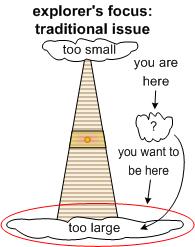
Goal: to move the explorer's focus from the interpersonal (from the realm of the guide - explorer) to the "too large" personal (to the realm of the explorer's intuition). Size of the final stage: still too large, but focused only the explorer. At this level, the guide's goal is to help the explorer to create what amounts to a traditional "issue." So while a traditional issue is too vague and impersonal to actually be a good stage for healing, it can be used to create a good issue statement, a sentence or phrase which is a good stage for healing. What makes a traditional issue a poor stage from which to heal? A traditional issue is so vague and impersonal that when asked to picture it, most explorers will either see only "floods" of pictures, which will cause them to get lost in trying to choose a picture, eventually putting them into indecision and shock, OR, they will get lost in a "blank page;" in essence, trying to resolve the indecision about which picture to chose will put the person into shock and they will see nothing. Finally, even when traditional issues do generate pictures in explorers, the pictures they generate can, at best, only stimulate "outside," mostly mental experiences in the explorer (as if they were coming from the person in the role of a "critic," a "watcher," or an "analyst," etc.). Thus, while traditional issues make poor stages from which to heal, they can be used to develop "issue statements." And because "issue statements" are specific enough and personal enough to be pictured, they will easily stimulate "inside" experiences in the explorer (living inner visions) and so, can readily be used as starting points from which to heal. Examples of questions which can be asked in order to help an explorer to the first level would be:
 |
.